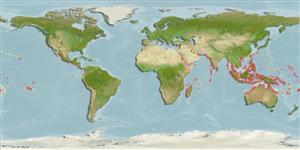Common names from other countries
>
Gobiiformes (Gobies) >
Gobiidae (Gobies) > Gobiinae
Etymology: Istigobius: Greek, istios = sail + Latin, gobius = gudgeon (Ref. 45335).
More on author: Rüppell.
Environment: milieu / climate zone / depth range / distribution range
Ecologie
marien; brak water rifbewoner; diepte 0 - 5 m (Ref. 86942). Tropical; 21°C - 29°C (Ref. 27115); 30°N - 25°S
Indo-Pacific: Red Sea south to northern Mozambique (Ref. 4343) and east to Fiji, north to southern Taiwan, south to New Caledonia. Recently recorded from Tonga (Ref. 53797).
Grootte / Gewicht / Leeftijd
Maturity: Lm ? range ? - ? cm
Max length : 11.0 cm TL mannelijk / geslacht onbekend; (Ref. 9710)
Dorsale stekels (totaal) : 7; Dorsale zachte stralen (totaal) : 10 - 12; Anale stekels: 1; Anale zachte stralen: 9 - 11; Wervels: 26. Upper 3-4 pectoral fin rays free. Body color pale gray; operculum with 5 small blue spots interspersed with brownish red spots; 5 vertical rows of white spots on pectoral fins; anterior tip of first dorsal fin bright yellow. 4th spine of 1st dorsal fin longest. Predorsal scales cycloid, trunk ctenoid. Mouth with overhanging snout, lips greatly thickened. Cheeks and operculae without scales. Female pelvic and anal fins not as darkly pigmented as in male. Also with terete body shape, slightly depressed; eyes situated dorso-laterally; reduced swim bladders (Ref. 92840).
A common species that inhabits mangroves and silty, rocky areas; occasionally found in rubble reef areas. Only single individuals were observed; many individuals found scattered over a small area (Ref. 420). Found primarily in lower estuaries, usually in mangroves. This is the species of the genus that is found farthest inland. Feeds on small invertebrates (Ref. 12693).
Levenscyclus en paargedrag
Maturities | Voortplanting | Spawnings | Egg(s) | Fecundities | Larven
Genital papilla, of male varying from lightly to heavily pigmented and terminating to side of anal spine. Female genital papilla lightly pigmented and truncate, terminating well before anal spine (Ref. 420). Benthic spawner (Ref. 32023).
Murdy, E.O. and D.F. Hoese, 1985. Revision of the gobiid fish genus Istigobius. Indo-Pac. Fish. (4):41 p. (Ref. 420)
Status op de Rode Lijst van het IUCN (Ref. 130435)
CITES (Ref. 128078)
Not Evaluated
Gevaar voor de mens
Harmless
Gebruik door de mens
Visserij: commercieel; Aquarium: Commercieel
Tools
Speciale rapporten
Download XML
Internetbronnen
Estimates based on models
Preferred temperature (Ref.
115969): 25.5 - 29.3, mean 28.5 (based on 3131 cells).
Fylogenetische diversiteitsindex (Ref.
82804): PD
50 = 0.5010 [Uniqueness, from 0.5 = low to 2.0 = high].
Bayesian length-weight: a=0.01096 (0.00647 - 0.01859), b=3.05 (2.91 - 3.19), in cm Total Length, based on LWR estimates for this species & (Sub)family-body (Ref.
93245).
Trofisch niveau (Ref.
69278): 4.3 ±0.26 se; based on food items.
Weerstandsvermogen (Ref.
120179): Hoog, minimale populatieverdubbelingstijd minder dan 15 maanden (Preliminary K or Fecundity.).
Fishing Vulnerability (Ref.
59153): Low vulnerability (10 of 100).
